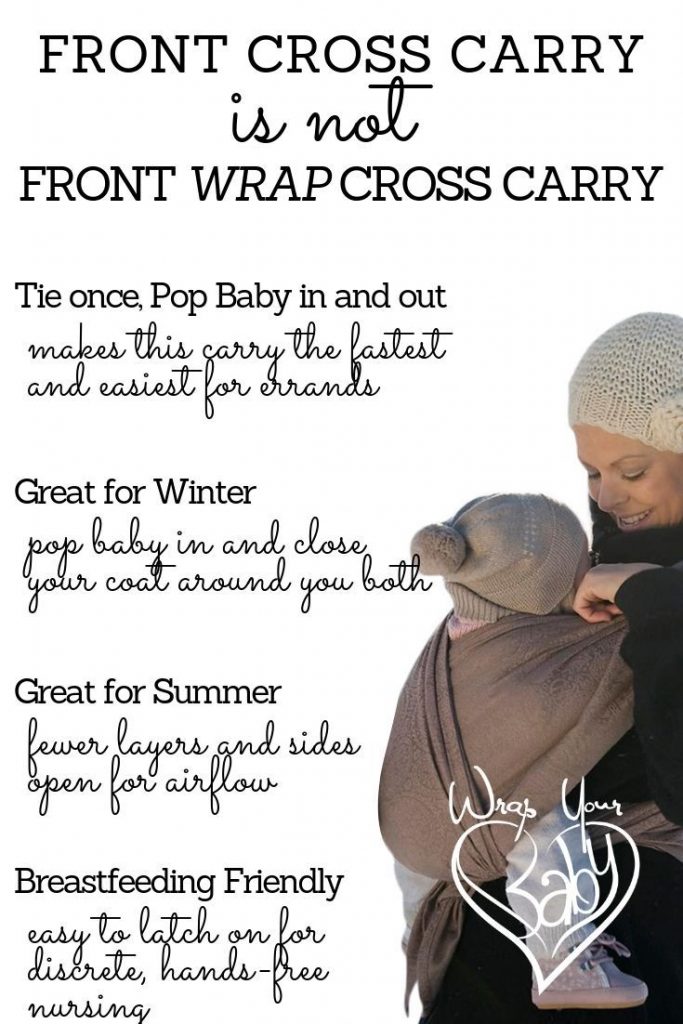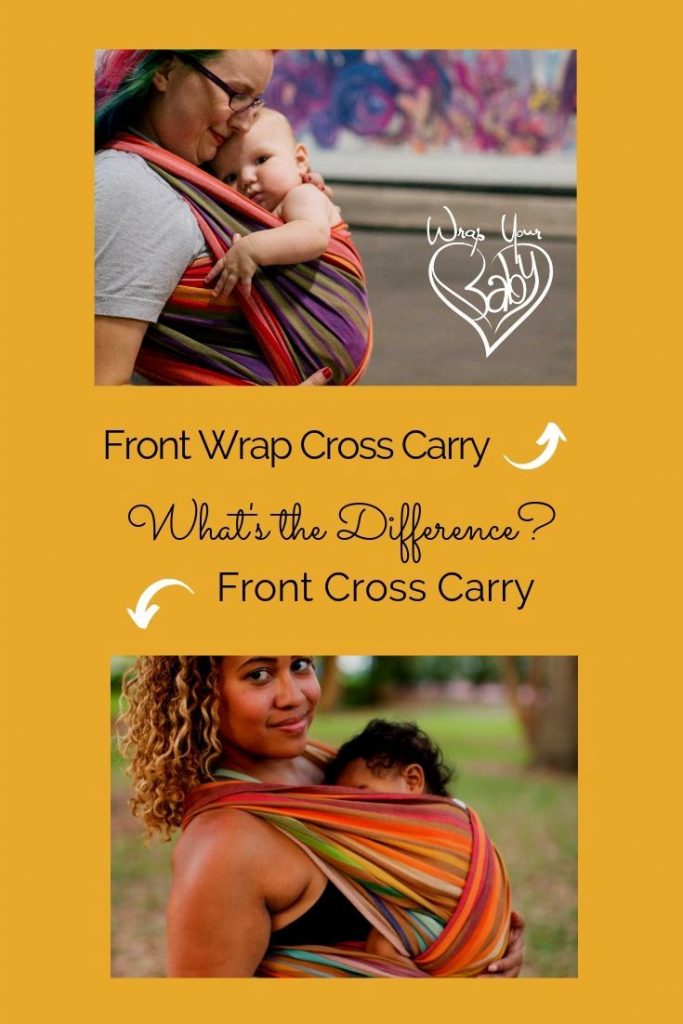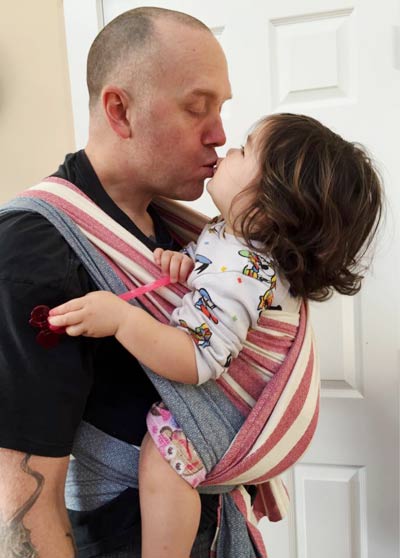FCC is NOT FWCC

What’s the difference between Front Cross Carry (FCC) & Front Wrap Cross Carry (FWCC)?
Front Wrap Cross Carry (FWCC) is the first carry most people learn. It’s the most popular way to use a woven wrap and can also be used with a stretchy wrap. It works for newborn through toddler, cuddling baby to your heart with three layers for a supportive carry with a full length wrap. Learn ALL about FWCC in my blog post, Woven Wrap Newbie: What is FWCC?
Front Cross Carry (FCC) sounds similar and so the names are often confused. However Front Cross Carry has only two layers over baby, instead of three. And the sides are open for airflow, whereas a FWCC has wrap around mom and baby’s sides. For these two reasons, Front Cross Carry can be noticeably cooler and more breathable in hot weather.
Front Cross Carry is a Poppable Carry:
One of the loveliest things about FCC is that you can pre-tie this carry and pop baby in and out without having to unwrap and retie.
Here’s how easy it is:
This makes FCC a super convenient carry. It’s the fastest, easiest way to wrap your baby.
- Wrap your baby at home in the morning.
- Pop baby out of the wrap without untying it, put your baby in the carseat and drive to the store or other errands.
- When you get there, take baby out of the carseat and pop baby back into your pretied Front Cross Carry in 5 seconds flat.
You can use this same functionality at home, popping baby out as often as needed for feeding, diaper changes, etc, and having your carry already tied and ready whenever you need to pop baby back in and have your hands free again.
You can learn more on my blog post Poppable Carry in a Woven Wrap – as Fast and Easy as a Ring Sling.
Front Cross Carry (FCC) is like a backwards FWCC:
Whereas FWCC starts with the center of the wrap at your chest, crosses in the back and then crosses over baby on your front, then ties in back; FCC starts with the center of the wrap at your back, crosses in the front over baby, crosses over your back, then ties in front.
So when you tie on a Front Cross Carry, you do it completely backward, but otherwise identical to how you do FWCC!

FCC: Middle at Your Back

FCC: Cross in Front, Cross in Back

FCC: Tie In Front Under Baby

FWCC: Middle at Your Front

FWCC: Cross in Back

Cross In Front, Tie in Back
Front Cross Carry with Sling Passes instead of Cross Passes:
You usually put your baby into a Front Cross Carry with one leg in each cross. This means the two passes cross between your baby’s legs.
But you can tie Front Cross Carry and then put your baby in with both legs coming under and out the bottom of both passes. Then the two cross passes become sling passes that cross high over baby’s back and each scoop both of baby’s knees upwards.
Here’s how to do that:
This can be helpful with a baby who tries to lean back out of the wrap, as the sling passes hold baby snug against your chest. It’s also a closer, cuddlier carry.
The below picture does not show Front Cross Carry but does show the difference between a cross pass and a sling pass:
Front Double Hammock Carry is a variation of Front Cross Carry:
Eventually, a version of this Front Cross Carry beneath the crosses became known as Front Double Hammock Carry (FDHC). Front Double Hammock Carry is usually done with flipped shoulders to keep even tension throughout the wrap job.
Here’s how to do Front Double Hammock Carry, which is a version of Front Cross Carry:
Breastfeeding in Front Cross Carry:
Front Cross Carry (as well as all of its variations) is a fantastic carry for nursing hands free and there are many ways to do it. One of the easiest is to untie the knot, bounce baby lower, retie, and latch on:

Semi Reclined Nursing Front Cross Carry
Here’s one way to adjust from upright in Front Cross Carry to semi-reclined for breastfeeding in the wrap. In this video, I slip the outer cross out from between baby’s legs to cradle her:
Newborn Front Cross Cradle Carry
Here’s how you can start with a pre-tied Front Cross Carry, start to put baby in and get baby latched on quickly (to prevent the common but unofficial frantic baby syndrome), and then finish adjusting the wrap around baby while she nurses.
What is the back carry version of FCC?
Double Hammock Carry (DHC) is like a Front Cross Carry (FCC) used as a back carry, if baby’s legs are put in beneath both passes, rather than with the crosses between baby’s legs. That’s why the above variation of Front Cross Carry became known as Front Double Hammock Carry.
Double Hammock has the center of the wrap at your chest, coming under your arms and crossing over baby on your back. The crosses come over your shoulders and then typically are brought straight down like rucksack (backpack) straps under the same arm to cross over baby’s legs and come around to tie in front.
Here is where it differs from a Front Cross Carry. Instead of crossing over your chest, when Front Cross Carry would cross your back, Double Hammock uses Rucksack straps. The rucksack straps are usually more comfortable and convenient in a back carry, whereas that cannot be done on your back – the straps would slide off your shoulders – and on your back (as in Front Cross Carry) would need to cross your back.
And instead of tying in the back under baby’s legs where Front Cross Carry would tie in the front under baby’s legs, Double Hammock Carry typically crosses baby’s legs and comes around to tie at the waist. This is more convenient than tying behind your back.
You can do a Double Hammock Carry tied behind under baby’s bottom, and that is a shorter variation called Double Hammock Carry TUB (tied under bottom), which you can do with a shorter wrap, one size smaller than your base (full length) size.
Here’s how to do Double Hammock TUB:

Middle at Your Back

Cross in Front, Cross in Back

Tie Under Baby

Middle at Your Front, Cross in Back

Straps Straight Down Instead of Crossing Over Front

Cross Between Baby’s Legs
Or Tie Under Baby in Double Hammock TUB
Ready to learn Front Cross Carry? Go here:








Leave a Comment